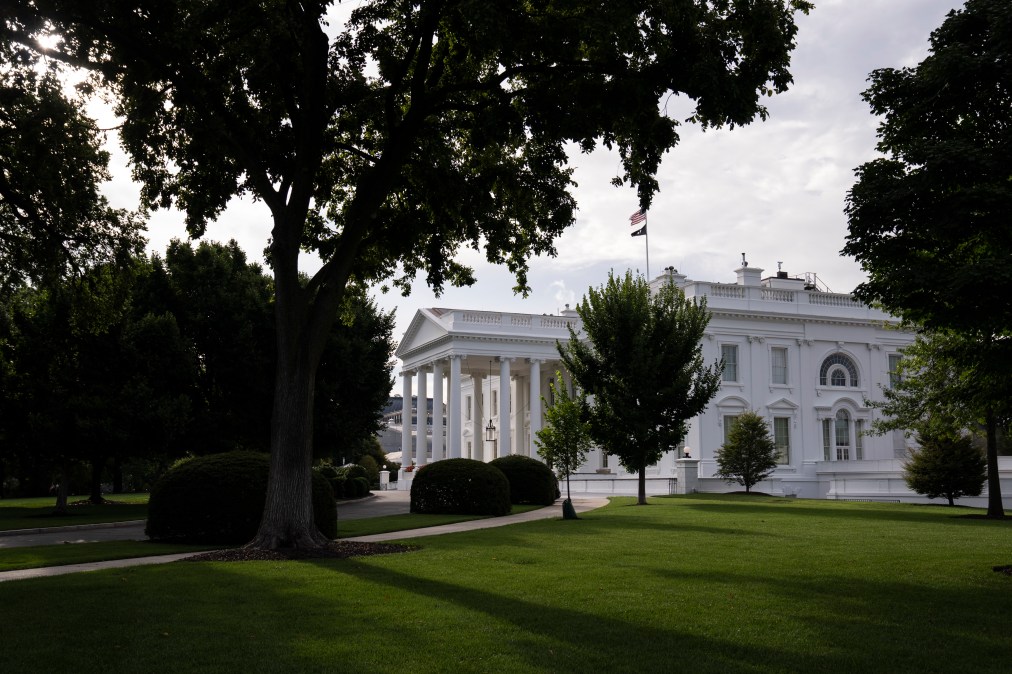- Exclusive
- AI
Experts warn of ‘contradictions’ in Biden administration’s top AI policy documents

The Biden administration’s cornerstone artificial intelligence policy documents, released in the past year, are inherently contradictory and provide confusing guidance for tech companies working to develop innovative products and the necessary safeguards around them, leading AI experts have warned.
Speaking with FedScoop, five AI policy experts said adhering to both the White House’s Blueprint for an AI ‘Bill of Rights’ and the AI Risk Management Framework (RMF), published by the National Institute of Standards and Technology, presents an obstacle for companies working to develop responsible AI products.
However, the White House and civil rights groups have pushed back on claims that the two voluntary AI safety frameworks send conflicting messages and have highlighted that they are a productive “starting point” in the absence of congressional action on AI.
The two policy documents form the foundation of the Biden administration’s approach to regulating artificial intelligence. But for many months, there has been an active debate among AI experts regarding how helpful — or in some cases hindering — the Biden administration’s dual approach to AI policymaking has been.
The White House’s Blueprint for an AI ‘Bill of Rights’ was published last October. It takes a rights-based approach to AI, focusing on broad fundamental human rights as a starting point for the regulation of the technology. That was followed by the risk-based AI RMF in January, which set out to determine the scale and scope of risks related to concrete use cases and recognized threats to instill trustworthiness into the technology.
Speaking with FedScoop, Daniel Castro, a technology policy scholar and vice president at the Information Technology and Innovation Foundation (ITIF), noted that there are “big, major philosophical differences in the approach taken by the two Biden AI policy documents,” which are creating “different [and] at times adverse” outcomes for the industry.
“A lot of companies that want to move forward with AI guidelines and frameworks want to be doing the right thing but they really need more clarity. They will not invest in AI safety if it’s confusing or going to be a wasted effort or if instead of the NIST AI framework they’re pushed towards the AI blueprint,” Castro said.
Castro’s thoughts were echoed by Adam Thierer of the libertarian nonprofit R Street Institute who said that despite a sincere attempt to emphasize democratic values within AI tools, there are “serious issues” with the Biden administration’s handling of AI policy driven by tensions between the two key AI frameworks.
“The Biden administration is trying to see how far it can get away with using their bully pulpit and jawboning tactics to get companies and agencies to follow their AI policies, particularly with the blueprint,” Thierer, senior fellow on the Technology and Innovation team at R Street, told FedScoop.
Two industry sources who spoke with FedScoop but wished to remain anonymous said they felt pushed toward the White House’s AI blueprint over the NIST AI framework in certain instances during meetings regarding AI policymaking with the White House’s Office of Science and Technology (OSTP).
Rep. Frank Lucas, R-Okla., chair of the House Science, Space and Technology Committee, and House Oversight Chairman Rep. James Comer, R-Ky., have been highly critical of the White House blueprint as it compares to the NIST AI Risk Management Framework, expressing concern earlier this year that the blueprint sends “conflicting messages about U.S. federal AI policy.”
In a letter obtained exclusively by FedScoop, Arati Prabhakar responded to those concerns, arguing that “these documents are not contradictory” and highlighting how closely the White House and NIST are working together on future regulation of the technology.
At the same time, some industry AI experts say the way in which the two documents define AI clash with one another.
Nicole Foster, who leads global AI and machine learning policy at Amazon Web Services, said chief among the concerns with the documents are diverging definitions of the technology itself. She told FedScoop earlier this year that “there are some inconsistencies between the two documents for sure. I think just at a basic level they don’t even define things like AI in the same way.”
Foster’s thoughts were echoed by Raj Iyer, global head of public sector at cloud software provider ServiceNow and former CIO of the U.S. Army, who believes the two frameworks are a good starting point to get industry engaged in AI policymaking but that they lack clarity.
“I feel like the two frameworks are complementary. But there’s clearly some ambiguity and vagueness in terms of definition,” said Iyer.
“So what does the White House mean by automated systems? Is it autonomous systems? Is it automated decision-making? What is it? I think it’s very clear that they did that to kind of steer away from wanting to have a direct conversation on AI,” Iyer added.
Hodan Omaar, an AI and quantum research scholar working with Castro at ITIF, said the two documents appear to members of the tech industry as if they are on different tracks. According to Omaar, the divergence creates a risk that organizations will simply defer to either the “Bill of Rights” or the NIST RMF and ignore the other.
“There are two things the White House should be doing. First, it should better elucidate the ways the Blueprint should be used in conjunction with the RMF. And second, it should better engage with stakeholders to gather input on how the Blueprint can be improved and better implemented by organizations,” Omaar told FedScoop.
In addition to compatibility concerns about the two documents, experts have also raised concerns about the process followed by the White House to take industry feedback in creating the documents.
Speaking with FedScoop anonymously in order to speak freely, one industry association AI official said that listening sessions held by the Office of Science and Technology Policy were not productive.
“The Bill of Rights and the development of that, we have quite a bit of concern because businesses were not properly consulted throughout that process,” the association official said.
The official added: “OSTP’s listening sessions were just not productive or helpful. We tried to actually provide input in ways in which businesses could help them through this process. Sadly, that’s just not what they wanted.”
The AI experts’ comments come as the Biden administration works to establish a regulatory framework that mitigates potential threats posed by the technology while supporting American AI innovation. Last month, the White House secured voluntary commitments from seven leading AI companies about how AI is used, and it is expected to issue a new executive order on AI safety in the coming weeks.
One of the contributors to the White House’s AI Blueprint sympathizes with concerns from industry leaders and AI experts regarding the confusion and complexity of the administration’s approach to AI policymaking. But it’s also an opportunity for companies seeking voluntary AI policymaking guidance to put more effort into asking themselves hard questions, he said.
“So I understand the concerns very much. And I feel the frustration. And I understand people just want clarity. But clarity will only come once you understand the implications, the broader values, discussion and the issues in the context of your own AI creations,” said Suresh Venkatasubramanian, a Brown University professor and former top official within the White House’s OSTP, where he helped co-author its Blueprint for an ‘AI Bill of Rights.’
“The goal is not to say: Do every single thing in these frameworks. It’s like, understand the issues, understand the values at play here. Understand the questions you need to be asking from the RMF and the Blueprint, and then make your own decisions,” said Venkatasubramanian.
On top of that, the White House Blueprint co-author wants those who criticize the documents’ perceived contradictions to be more specific in their complaints.
“Tell me a question in the NIST RMF that contradicts a broader goal in the White House blueprint — find one for me, or two or three. I’m not saying this because I think they don’t exist. I’m saying this because if you could come up with these examples, then we could think through what can we do about it?” he said.
Venkatasubramanian added that he feels the White House AI blueprint in particular has faced resistance from industry because “for the first time someone in a position of power came out and said: What about the people?” when it comes to tech innovation and regulations.
Civil rights groups like the Electronic Privacy Information Center have also joined the greater discussion about AI regulations, pushing back on the notion that industry groups should play any significant role in the policymaking of a rights-based document created by the White House.
“I’m sorry that industry is upset that a policy document is not reflective of their incentives, which is just to make money and take people’s data and make whatever decisions they want to make more contracts. It’s a policy document, they don’t get to write it,” said Ben Winters, the senior counsel at EPIC, where he leads their work on AI and human rights.
Groups like EPIC and a number of others have called upon the Biden administration to take more aggressive steps to protect the public from the potential harms of AI.
“I actually don’t think that the Biden administration has taken a super aggressive role when trying to implement these two frameworks and policies that the administration has set forth. When it comes to using the frameworks for any use of AI within the government or federal contractors or recipients of federal funds, they’re not doing enough in terms of using their bully pulpit and applying pressure. I really don’t think they’re doing too much yet,” said Winters.
Meanwhile, the White House has maintained that the two AI documents were created for different purposes but designed to be used side-by-side as initial voluntary guidance, noting that both OSTP and NIST were involved in the creation of both frameworks.
OSTP spokesperson Subhan Cheema said: “President Biden has been clear that companies have a fundamental responsibility to ensure their products are safe before they are released to the public, and that innovation must not come at the expense of people’s rights and safety. That’s why the administration has moved with urgency to advance responsible innovation that manage the risks posed by AI and seize its promise — including by securing voluntary commitments from seven leading AI companies that will help move us toward AI development that is more safe, secure, and trustworthy.”
“These commitments are a critical step forward and build on the administration’s Blueprint for an AI Bill of Rights and AI Risk Management Framework. The administration is also currently developing an executive order that will ensure the federal government is doing everything in its power to support responsible innovation and protect people’s rights and safety, and will also pursue bipartisan legislation to help America lead the way in responsible innovation,” Cheema added.
NIST did not respond to requests for comment.




